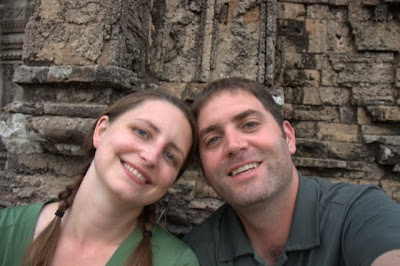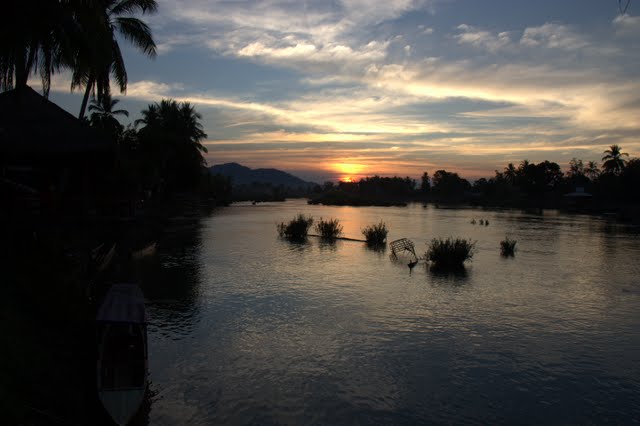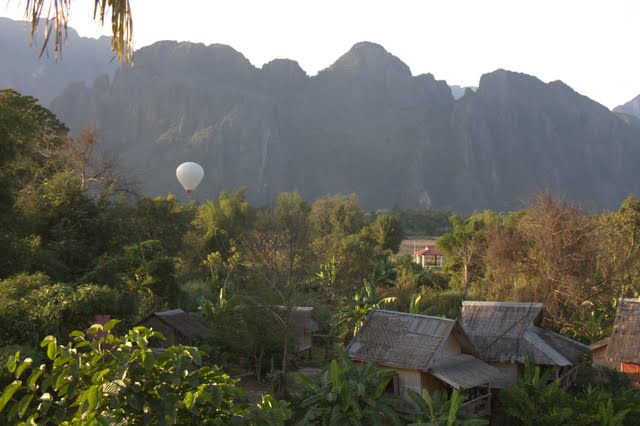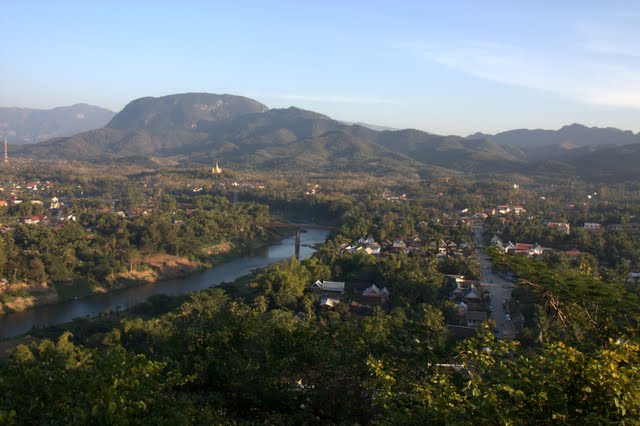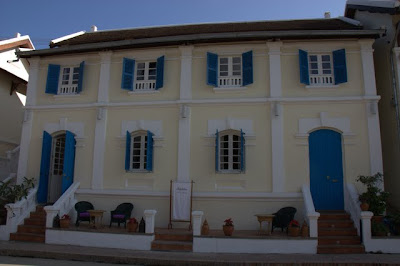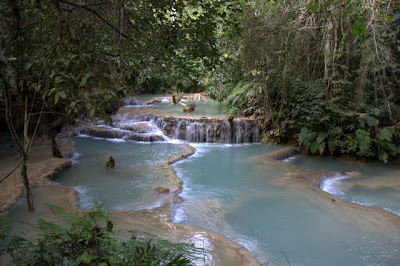Scenes from Angkor Wat: Day One
The temple complex of Angkor Wat is a UNESCO World Heritage site and one of the great ruins of the world. Angkor likely was the largest preindustrial city in the world, with an elaborate system of infrastructure connecting an urban sprawl of at least 1000 square kilometres to the well-known temples at its core. It served as the seat of the Khmer Empire, which flourished from approximately the 9th to 13th centuries.
We spent two hot, sweaty days dodging persistent vendors and exploring a portion of the ruins, scrambling up and down rocks and stairs to marvel at the grandeur and intricacy of the temples. Here’s scenes from some of the temples we visited on day one:
Angkor Thom
Preah Khan (I think!)
Ta Som
Banteay Srei
Pre Rup
p.s. Happy St. Patrick’s Day!
Last Stop in Laos: 4,000 Islands
The 4,000 Islands are a group of islands dotting the Mekong River in the very south of Laos near the Cambodian border. I’d heard there was pretty much nothing to do there but sit in a hammock. After four days of motorbiking the Bolaven Plateau, hammock-sitting sounded like a darn good idea.
Although there are supposedly 4,000 of them, foreigners only seem to visit three of them. We chose Don Khon, because we’d heard it was laid-back, and didn’t have a big party scene like Don Dhet. (And this was true, right up until a super chatty Aussie girl and pot smoking Canadian boy moved in next door, but I digress).
The hammock sitting on Don Khon turned out to be a bit of a bust. We only could find riverside accommodations for our second night, and the hammock to floor ratio was not quite right once you actually sat in the hammock. Plus the addition of millions of river gnats feasting on my skin made it less than pleasant to sit outside. But despite the hammock fail, three things in particular made our short time on Don Dhon worthwhile:
Amazing Sunsets. Watching the sunset over the Mekong never gets old.
The Little Waitress. We randomly picked one of the many restaurants lining the riverfront for dinner and were met by a pint-sized waitress. She had to have been no more than ten years old and her English was impeccable. She accessorized her t-shirt and traditional Lao skirt with a glittery purse and a beaded necklace, and she carried herself with poise and grace. In between taking our order, she peppered us with questions about where we were from, telling us her mother and sister were in America. She returned to her desk, where she sat dutifully doing her homework until our order was up. I wondered what her dreams were like. Would she stay on this tiny island in the middle of Laos, serving in her family’s restaurant? Would she join her mother and sister in the United States when she got older? Would she go somewhere else? We’ve seen plenty of children working in their family business or alongside their parents elsewhere – child labor laws do not exist over here – but the maturity of this little girl stood out to me.
The Chicken Boy. Right before sunset on our first night, Sean and I walked the path away from the strip of restaurants, towards the place where the islanders lived. The river, the palm trees, the fields – they were all bathed in the magical light of the Golden Hour. Out of nowhere, a little boy appeared further on down the path, barrelling towards us. We had seen him earlier, clutching a chick in his hand by the neck. We weren’t sure if the chick was real or stuffed, dead or alive, but the way the chick was flopping its head around listlessly told us its fate. I saw that the boy was till clutching the chick as if it was a stuffed animal as he passed me, making a beeline straight for Sean. The boy slammed into Sean’s legs, hugging him tight around the knees. When the hug was over, he looked up at Sean, grinning. We had no idea why he decided to give this tall foreigner a sudden hug, but it was one of the cutest things I have ever seen.

Lao children crossing the Silly French Bridge from Don Khon to Don Dhet. (No idea why, but Travelfish called it the Silly French Bridge and so did we).

Bike riding didn't go so well on the bumpy pathways crisscrossing the island, but we gave it the old college try before I threw in the towel.
Hog Tales – Motorbiking the Bolaven Plateau, Days Three and Four: Born to Run (Provided We Have Cushier Seats)
Someday girl I don’t know when we’re gonna get to that place
Where we really want to go and we’ll walk in the sun
But till then tramps like us baby we were born to run– Born to Run, Bruce Springsteen
We awoke early on Day 3 and set off from Paksong towards Tad Lo, determined to put our previous day’s mishaps behind us. I’m not going to lie – we both were still a little gun shy – but cruising along on the paved roads seemed like a cinch after navigating the soft dirt of the day before.
Once again, the sun was shining and the fluffy clouds were out in full force. Mountains dotted the backdrop of the landscape. As we headed away from Paksong, the chill in the air disappeared. Before long, smiles reappeared on our faces and the only sign of our spills was the dirt caked into our clothes. (Oh, didn’t I mention were were wearing the same clothes for the third day in the row? It is not like we had a lot of options for chilly weather anyhow, and we’d left most of our stuff behind in locked storage at the Pakse Hotel to lighten the load for the bike. Months later, there’s still traces of the orangeish brown dirt on our daybag, our trail runners, and Sean’s pants where he hit the hardest).
Considering our current state of dishevelment, we hesitated when, out of the blue, we came across a fancy resort and coffee plantation advertising tours of their gardens and cups of coffee. The resort seemed out of place in the middle of very rural Laos, but the colorful flowers we could see from the road looked so inviting and we welcomed any excuse to hop off our bike. We soaked up the sunshine as we drank coffee from the plantation and watched women weave Lao silk into scarves. Afterwards, we strolled through the grounds and checked out the coffee trees, ponds, and gardens. Groups of butterflies danced around the garden. If it sounds like a little oasis, a little Eden, it was.
But we still had a ways to Tad Lo, so we continued down the road, passing through villages with roaming pigs and cows with real cowbells, schoolgirls walking to school in their traditional skirts, and roadside stands selling steaming bowls of noodle soup and Beer Lao.
We arrived in Tad Lo in mid-afternoon. Tad Lo, which is not too far from Pakse and home to several gushing waterfalls, is one of the more popular spots on the Bolaven Plateau. Whereas in Paksong, supply far outweighed demand (as a result of people being just a little too hopeful about the somewhat increased tourism), in Tad Lo, we had trouble finding a place to stay. Most everything in town was booked, leaving our choices as a primitive $4.50 hut with a neighbor in the other half and a shared bathroom with cold water, or a $19.75 cabin up on the hill next to a big waterfall. The $19.75 place left a lot to be desired, and the $4.50 price was tempting, but in the end, we value privacy and hot water.
After traversing the town’s rickety bridge more times that I would have liked and checking out the waterfalls, we ended the day with Beer Laos next to the waterfall gushing to the right and monks frolicking in the river to our left. Day three? Not too shabby.
Day four, on the other hand, was rather uneventful. In the morning, we stopped by a road stall for some noodle soup on our way out of town. Like most roadside stalls, the restaurant doubles as the family’s home, meaning you are eating at plastic tables steps from the family’s television (everyone’s got a television, even in the Lao boonies!) and beds. As we waited for the preteen girl to serve us our breakfast, I did a double take. Were those? Are those? Staring me right in the face were not one, but two large posters of a completely topless girl. The posters looked like something that might have been hung illicitly in a warehouse of one of my former clients’ places and later made an exhibit in a sexual harassment case. I looked around. The only people I saw were the preteen girl preparing our soup, and her mother nearby. It was very bizarre, very bizarre indeed, especially considering we were in one of the more traditional, conservative countries in Southeast Asia where locals sometimes can be offended by the shorts and tank tops worn by Western tourists.
Other than some surprise breakfast boobs, there’s not too much noteworthy about our return to Pakse. The day was mostly characterized by extreme discomfort in the rear end. Sure, maybe a motorbike could hold two people and a small bag for four days, but should it? I must have made Sean pull over at least every ten minutes during the last hour. But we finally made it, pulling into Pakse rather dirtier than we had been four days ago, with all feeling in our butts lost forever, but glad we saw a side of Laos we wouldn’t have seen otherwise.
If it hasn’t been your day, your week, your month or even your year…
To say I was not a fan of Vang Vieng is only putting it mildly. Vang Vieng is a small town between Luang Prabang and Laos’ capital city, Vientiane, located among limestone mountain karsts and the Nam Song River. Its claim to fame is being a party mecca for young backpackers who come there to go tubing down the beautiful river and allow themselves to be reeled in to shore to drink Beer Lao and Lao-Lao whiskey by the bucketful. Sean had no interest in tubing, so we only stopped overnight to check out the scenery and break up the trip between Luang Prabang and Vientiane. By all accounts, Vang Vieng is touristy, Westernized, and rowdy, and most travelers whose blogs I read seemed to view Vang Vieng as a guilty pleasure after their visits. So I was prepared to see some good-natured debauchery and even the strange phenomenon of cafe after cafe running endless loops of Friends, the Simpsons, and Family Guy.
But I underestimated the scene in Vang Vieng. I know lots of people love it, and I’m sure I sound like the old, thirty-something fuddy-duddy that I am, but to me, Vang Vieng is a giant frat party gone out of control. From dusk onward, the streets are filled with stumbling, obnoxious kids clad only in skimpy bathing suits (in a very conservative country) and with lewd sayings written in marker up and down their bodies. As one group stumbled by, cackling and shouting, a bikini-clad girl filled her companion’s cup to the brim with whiskey. He chugged it down and threw his cup on the street while yelling “F*ck yeah!” like he was in the basement of a college house and not a guest in someone else’s country.
Despite listening to pounding bass late into the night (thank you Travelfish reviewers who called our hotel “quiet;” you apparently are deaf or didn’t come back to the room until 4 a.m.), we decided to take the afternoon bus to Vientiane and first check out an organic farm up the river. If we thought this would get us away from the rowdiness in town we’d be sadly mistaken; the farm has the unfortunate location of being right near the start of the tubing. This means instead of peaceful sounds of birds chirping, the farm gets to hear the sounds of competing music screeching out over the river.
Other than the noise pollution, the farm was lovely. We took a tour led by “Mr. T”, a little Laotian man who is passionate about organic farming and leading by example. He hopes to show other local farmers that organic farming can be profitable and healthy. The farm centers around its mulberry trees, used for mulberry tea, mulberry wine, mulberry tempura and most deliciously, mulberry shakes. The farm also grows organic vegetables and fruits (we saw starfruit and jackfruit trees, for example) and has chickens, pigs, and goats. In addition to sustainable farming, the farm also runs various projects for the community, such as building inexpensive housing out of local materials, paying fair wages to local people, running schools for local kids, and a goat lending program where locals receive goats and repay their debt with baby goats.
Hearing about one man’s efforts to better the local community made me less cranky about our stopover in Vang Vieng (or at least until the tuk-tuk driver insisted on charging us $5 to return to town even though they were already going that way any way to pick up more tubers). Besides eating delicious fresh organic meals by the river, and learning more about organic farming in a third-world Communist country, it gave me a different perspective on the party scene in Vang Vieng that I wish more travelers would consider. There’s nothing wrong with having a good time, but it shouldn’t be at the expense of a community. I’m not even talking about people’s claim that Vang Vieng is a former shell of its former, sleepy self and that its Lao culture had disappeared; that happens to a lot of places where tourism takes over. I’m talking more specifically about the locals who lived by the river long before tubing came to town, who have to listen to the partying day in and day out, who can’t afford or who don’t want to move. I’m talking about the little Lao kids who see the drunk, raunchy foreigners and think all foreigners are that way or that it is an appropriate way to behave. Both the travelers who participate in behavior they wouldn’t necessarily engage in at home and locals who profit from the travelers are all complicit. There’s nothing wrong with letting loose and having a few beers and some fun, but I wish more travelers would think more about the consequences of their actions.
Now that I’m done ranting, if you could please get off my lawn.

Mr. T greeted the goats with "Bonjour" instead of "Sabaidee." Most of the goats, used for the farm's community lending program and to make goat's cheese, were donated by a Frenchman.

If you don't think about how they are destined to become your bacon, these baby pigs are adorable. We watched this pink guy doggedly worm his way in between his polka-dotted buddies.
Lou-ahng Prah-bang
I’m really bad at foreign pronunciations. Like, REALLY bad. And Sean isn’t much better, which usually leads to horrendous butchering of our upcoming destinations until we can get there and figure out how in the hell to say the names. I even mispronounce easy words. I always pick the wrong way to say it. But wouldn’t you agree that Lou-ahng Prah-bang is so much more fun to say than Lou-ong Prah-bong? I thought so.
Our eight days in Luang Prabang, like much of our time in Laos, were spent chilling and taking in the lovely surroundings. We’d usually muster up the energy to engage in one “activity” per day, if you count eating chocolate chip cookies at our favorite cafe as an activity, which I do.

Rules on the back of our hotel door. Number 5 amused me because it apparently okay to have a one night stand, just as long as no love is involved. Number 6 is very upsetting and foiled our plans.
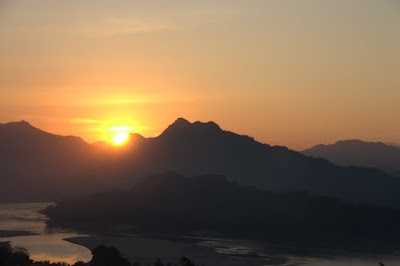
Sunset over the Mekong viewed from Phou Si Hill. Where you get a great view of the Mekong and the gorgeous greenery around town (see above)...

...shared with hundreds of your new best friends. Yes, you won't be the only one in Luang Prabang, and you probably won't learn much about local culture while your there, but gosh darn it, Luang Prabang is beautiful.

The Luang Prabang night market. We must have walked through it at least once per day but never bought anything. I may or may not have added to my growing scarf collection from one of the fair trade stores in town, however.

A hundred thousand times better than getting up at the crack of dawn to watch the alms giving ceremony is simply monk-spotting around town. We spotted these monks having fun and goofing around during bath time in the river. Every thing about the moment was beautiful - the lighting in the late afternoon sun, their orange robes against the riverside greens, the spontaneity of it all, and the joy of the monks without our intrusion on their fun. (If you go to the alms ceremony, which we did, I know you won't be THAT tourist who sticks his or her camera right in the monks' faces, right? We saw way too many of THOSE tourists treating the monks like zoo animals instead of showing respect for their religious ceremony).

Along Luang Prabang's riverfront. Luang Prabang sits alluringly between the Mekong River and the Mae Kok River.

In a town full of cafes, Saffron was our absolute favorite. Between their free wi-fi, real deal chocolate chip cookies, their organic, fair-trade local coffee, and their huge breakfast combos with bacon and cheese eggel bagels, tropical fruit salad, and cinnamon rolls, we were in heaven.

The French Indochinese architecture around town is what put Luang Prabang on the map as a UNESCO World Heritage Site.

Veggie street buffet. Gotta love a heaping plateful of dinner for just $1.25. Choose your dishes wisely - the ladies running the buffet dump all your choices together to heat them up.

Kouang Si Waterfalls, outside of Luang Prabang. The most gorgeous falls we've seen - since Plitvice National Park, that is.













